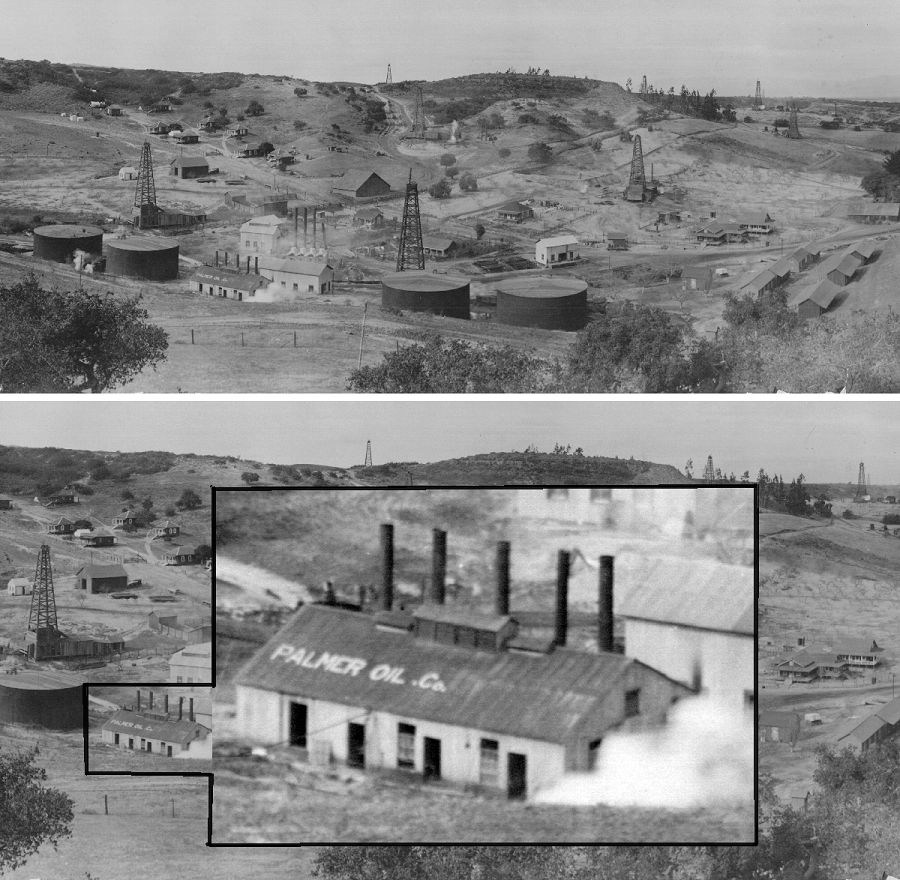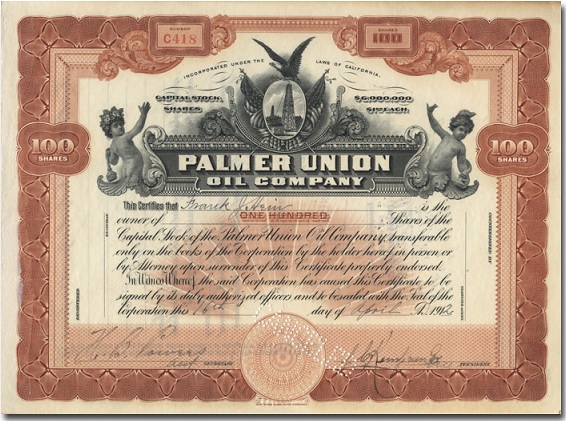Oilfield discovery in 1908 at Cat Canyon, California, began company’s lengthy corporate convolution.
In the Solomon Hills of central Santa Barbara County, California, the search for oil and natural gas began in 1904 at Cat Canyon. Exploration companies unsuccessfully drilled there for four years before Palmer Oil Company discovered an oilfield about 10 miles southeast of Santa Maria.

Palmer Oil Company derricks and refinery in Santa Barbara County, California, circa 1920s.
Palmer Oil’s Santa Maria well initially produced 150 barrels of oil a day, but within a few months it jumped to 10,000 barrels a day. The company completed a second well that also proved to be a true gusher. With it and other 1908 discoveries, Palmer Oil opened the Cat Canyon oilfield — the largest in Santa Barbara County at the time.
“The Palmer Oil Company is generally concluded to have opened one of the biggest and richest oil fields in California by the bringing in of its two gushers in the Cat Canyon District, now doing 10,000 barrels per day between them,” declared the trade publication “Oil Age Weekly” on September 9, 1910.
Although the Cat Canyon oilfield produced “heavy oil” with a high sulfur content, the success of Palmer Oil brought new investors, and the company was capitalized at $10 million by the beginning of 1911. The latest oil boom (see First California Oil Wells) attracted 26 exploration companies that completed 35 producing wells.

By 1927, Palmer Oil Company had reorganized into Palmer Union Oil Company as it continued to drill on Santa Barbara, California, leases.
By 1927, despite Cat Canyon’s proven oil reserves, drilling and production challenges of the heavy, high sulfur content prompted investors to look for better returns on their investments.
Palmer Oil to Coca-Cola
New drilling in Cat Canyon stalled — as did Palmer Oil, which began the first of its many corporate convolutions by becoming the Palmer Union Oil Company.
In January 1932, Palmer Union Oil became Palmer Stendel Oil Corporation, beginning decades of mergers and acquisitions: Palmer Stendel Oil Company – Petrocarbon Chemicals Incorporated – Great Western Producers – Pleasant Valley Wine Company – Taylor Wine Company – Coca-Cola Company.
After the Great Depression and World War II, water-flooding technology resurrected the Cat Canyon field’s production capability to a peak in 1953. Millions of barrels of oil were recovered and even in 1983, production was still about 350 barrels a day.
One century after its discovery by Palmer Oil Company, the Cat Canyon oilfield had 243 active oil wells. In a state long known for its natural oil seeps, enhanced recovery technologies revived oil production in Santa Barbara County and California’s other heavy oil-producing regions.
To extract reserves previously considered unrecoverable, companies like HVI Cat Canyon (Greka Energy), ERG Resources, and others used tertiary thermal recovery techniques. Improved technologies have dramatically lessened dangers to the environment, but not eliminated them.

A 1927 Palmer Union Oil Company stock certificate purchased at a garage sale in 2008 sparked a legal battle with Coca-Cola.
In 2023, a U.S. District Court found HVI Cat Canyon Inc. (formerly Greka Oil & Gas Company) liable for oil spills and ordered the company to pay $40 million in civil penalties for the spills; $15 million for violations of federal regulations, and $2.5 million in cleanup costs.
The U. S. Energy Information Administration in 2013 ranked Cat Canyon as 17th on its list of the nation’s top 100 producing oilfields — with no company having partial ownership in Coca-Cola Company (see Not a Millionaire from Old Oil Stock).
_______________________
The American Oil & Gas Historical Society (AOGHS) preserves U.S. petroleum history. Become an AOGHS annual supporting member and help maintain this energy education website and expand historical research. For more information, contact bawells@aoghs.org. Copyright © 2023 Bruce A. Wells. All rights reserved.
Citation Information – Article Title: “Palmer Oil Company.” Authors: B.A. Wells and K.L. Wells. Website Name: American Oil & Gas Historical Society. URL:https://aoghs.org/old-oil-stocks/palmer-oil-company. Last Updated: December 7, 2023. Original Published Date: December 7, 2023.


